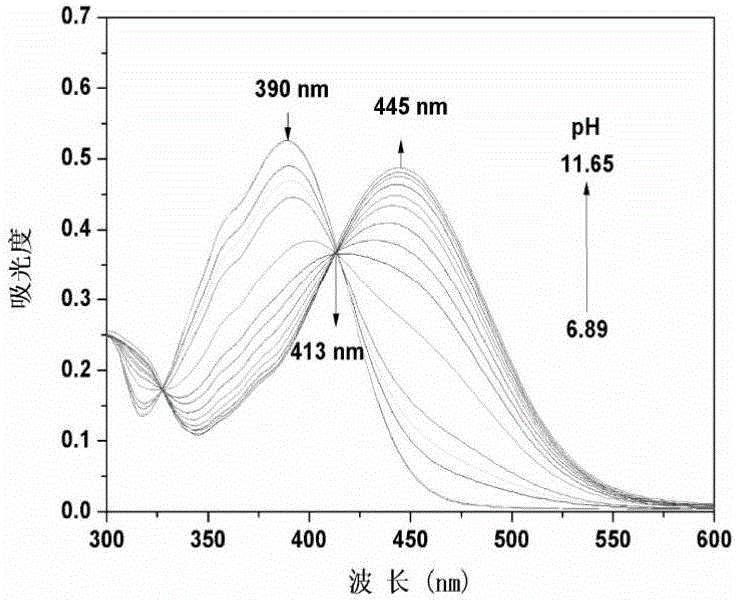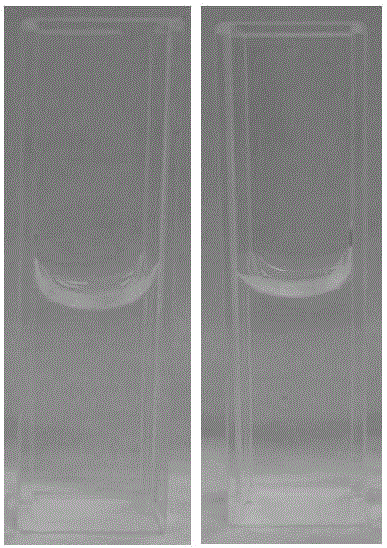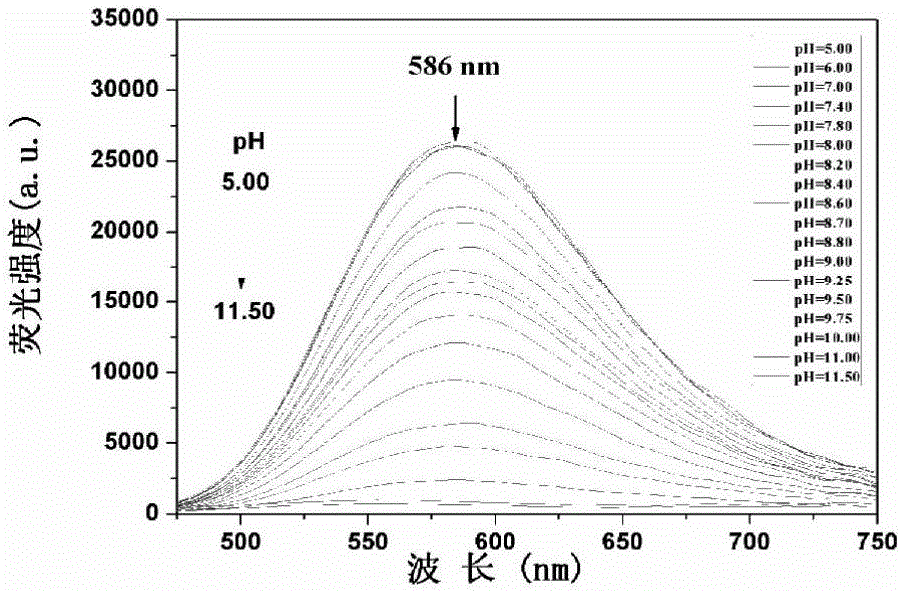Application of naphthyl derivatives used as targeted pH fluorescent probes for mitochondria
A technology of fluorescent probes and mitochondria, applied in the field of pH fluorescent probes, to achieve highly sensitive detection of pH changes, reduced interference of excitation light, and good cell membrane permeability
- Summary
- Abstract
- Description
- Claims
- Application Information
AI Technical Summary
Problems solved by technology
Method used
Image
Examples
Embodiment 1
[0020] With the probe HNEP in embodiment 1 + Use secondary water (conductivity 18.2) to prepare a stock solution with a concentration of 1 mM for storage. In the experiment, the probe was diluted to a final concentration of 10 μM with phosphate buffered saline (PBS) of different pH values, and the HNEP was recorded + In the PBS system, the ultraviolet absorption spectrum ( figure 1 ). As the pH value increased from 6.89 to 11.65, the absorption peak at 390nm decreased sequentially, the absorption peak at 445nm gradually increased, and an obvious isoabsorptive point appeared near 413nm. At the same time, the color of the solution changed from yellow to colorless ( figure 2 ).
Embodiment 2
[0022] The probe HNEP was also treated with different pH values of phosphate buffer + Dilute to a final concentration of 10μM, fix the excitation wavelength at 317nm, record HNEP + Fluorescence emission spectrum changes with pH changes in PBS system ( image 3 ). As the pH value increases from 5.00 to 11.50, the fluorescence intensity at 586nm decreases gradually, which is suitable for the detection of pH changes in the alkaline environment (pH ~ 8.0) in mitochondria. Under the irradiation of ultraviolet light, the color of the solution changed from yellow to colorless ( Figure 4 ). According to HNEP + The Singmoidal fitting curve of the fluorescence intensity at 586nm as a function of pH ( Figure 5 ), calculate pK a The value is 8.8, and the pH response is linear in the range of 7.8-10.0. The linear regression equation is I=-9151.11×pH+94210.98, the correlation coefficient R 2 = 0.9948.
Embodiment 3
[0024] With the probe HNEP in embodiment 1 + The concentration was kept at 10 μM, and the effect of the probe on H in the presence of common ions and amino acids was investigated + selectivity. Such as Figure 6 As shown, in the PBS system, at pH 7.0, the probe has almost no response to the above substances, proving that HNEP + to H + Has high selectivity. Figure 6 The sequence and concentration of the substances in it are as follows: 1, blank; 2, F - (1mM); 3, Cl - (10mM); 4, Br - (1 mM); 5, I - (1mM); 6, SO 4 2- (1mM); 7,S 2 o 3 2- (1mM); 8,SO 3 2- (1mM); 9,HS - (1mM); 10, NO 3 - (1mM); 11, NO 2 - (1mM); 12,Ac - (1mM); 13, HCO 3 - (1mM); 14, ClO 4 - (1mM); 15,K + (140mM); 16,Cd 2+ (1mM); 17, Mg 2+ (1mM); 18, Li + (1mM); 19,Co 2+ (1mM); 20, Hg 2+ (1mM); 21, Ba 2+ (1mM); 22,Ni 2+ (1mM); 23,H 2 o 2 (1mM); 24,L-GSH(1mM); 25,Hcy(1mM); 26,Cys(1mM).
PUM
 Login to View More
Login to View More Abstract
Description
Claims
Application Information
 Login to View More
Login to View More - R&D
- Intellectual Property
- Life Sciences
- Materials
- Tech Scout
- Unparalleled Data Quality
- Higher Quality Content
- 60% Fewer Hallucinations
Browse by: Latest US Patents, China's latest patents, Technical Efficacy Thesaurus, Application Domain, Technology Topic, Popular Technical Reports.
© 2025 PatSnap. All rights reserved.Legal|Privacy policy|Modern Slavery Act Transparency Statement|Sitemap|About US| Contact US: help@patsnap.com



